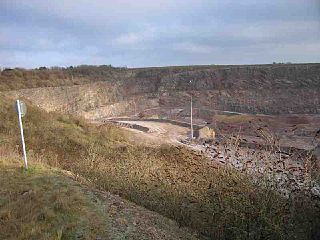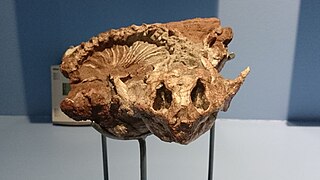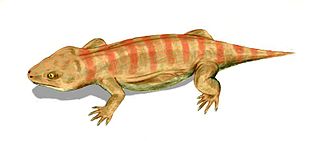
Hypsognathus is an extinct genus of procolophonid parareptile from the Late Triassic of New Jersey, Connecticut, and Nova Scotia.

Slickstones Quarry, Cromhall, also known as Cromhall Quarry, is a 2.7 hectare geological Site of Special Scientific Interest near the village of Cromhall, South Gloucestershire, England notified in 1966.

Procolophonidae is an extinct family of small, lizard-like parareptiles known from the Late Permian to Late Triassic that were distributed across Pangaea, having been reported from Europe, North America, China, South Africa, South America, Antarctica and Australia. The most primitive procolophonids were likely insectiovous or omnivorous, more derived members of the clade developed bicusped molars, and were likely herbivorous feeding on high fiber vegetation or durophagous omnivores. Many members of the group are noted for spines projecting from the quadratojugal bone of the skull, which likely served a defensive purpose as well as possibly also for display. At least some taxa were likely fossorial burrowers. While diverse during the Early and Middle Triassic, they had very low diversity during the Late Triassic, and were extinct by the beginning of the Jurassic.

Colemans Quarry, grid reference ST726452 is a limestone quarry at Holwell, near Nunney on the Mendip Hills, Somerset, England.

Clevosaurus is an extinct genus of rhynchocephalian reptile from the Late Triassic and the Early Jurassic periods. Species of Clevosaurus were widespread across Pangaea, and have been found on all continents except Australia and Antarctica. Five species of Clevosaurus have been found in ancient fissure fill deposits in south-west England and Wales, alongside other sphenodontians, early mammals and dinosaurs. In regards to its Pangaean distribution, C. hadroprodon is the oldest record of a sphenodontian from Gondwana, though its affinity to Clevosaurus has been questioned.

The Magnesian Conglomerate is a geological formation in Clifton, Bristol in England, Gloucestershire and southern Wales, present in Tytherington, Durdham Down, Slickstones Quarry and Cromhall Quarry.
Soleniscidae is an extinct family of fossil sea snails, marine gastropod mollusks in the clade Caenogastropoda. It first was seen on the 431 – 427 Ma (Silurian) and its last recorded appearance was in Late Triassic. It is found in the Americas, South Asia and Asian islands, Europe, Northern edge of Africa.
Plagioscutum is an extinct genus of Middle Triassic temnospondyl amphibian from the Ladinian Inder Formation of Kazakhstan and the Anisian Donguz Formation of Russia.
Tricuspisaurus is an extinct genus of reptile originally described as a trilophosaurid; it was later considered likely to be a procolophonid, but recent analyses have affirmed the original classification. Fossils are known from the Ruthin Quarry in Glamorgan, Wales, one of several Late Triassic to Early Jurassic British fissure deposits. Like some trilophosaurs, it has an edentulous, or toothless beak. Tricuspisaurus gets its name from its heterodont dentition, which includes tricuspid teeth, or teeth with three cusps. The type species, T. thomasi, was named in 1957 along with the possible trilophosaur Variodens inopinatus from Somerset, England.
Malutinisuchus is an extinct genus of Archosauromorph. The genus was named in 1986 with the description of the type species M. gratus. Malutinisuchus is known from Ladinian-age Middle Triassic deposits in the Bukobay and Rassypnaya localities in Orenburg Oblast, Russia. In Russia, deposits of this age are referred to the Bukobay Gorizont.
Phaanthosaurus is an extinct genus of basal procolophonid parareptile from early Triassic deposits of Nizhnii Novgorod, Russian Federation. It is known from the holotype PIN 1025/1, a mandible. It was collected from Vetluga River, Spasskoe village and referred to the Vokhmian terrestrial horizon of the Vokhma Formation. It was first named by P. K. Chudinov and B. P. Vjushkov in 1956 and the type species is Phaanthosaurus ignatjevi.

Teratophon is an extinct genus of procolophonine procolophonid parareptile from middle Triassic deposits of Free State Province, South Africa. It is known from the holotype BP/1/4299, a nearly complete skull. It was collected by the South African palaeontologist, James W. Kitching from Hugoskop in the Rouxville District and referred to subzone B of the Cynognathus Assemblage Zone of the Burgersdorp Formation, Beaufort Group. It was first named by Sean P. Modesto and Ross J. Damiani in 2003 and the type species is Teratophon spinigenis. It was first assigned to a species of Thelegnathus, Thelegnathus spinigenis. The distinguishing feature of this genus is a noticeable posterolateral spine-like process of the quadratojugal.
Thelerpeton is an extinct genus of procolophonine procolophonid parareptile from middle Triassic deposits of Free State Province, South Africa. It is known from the holotype BP/1/4538, a nearly complete skull. It was collected by the South African palaeontologist, James W. Kitching from Hugoskop in the Rouxville District and referred to subzone B of the Cynognathus Assemblage Zone of the Burgersdorp Formation, Beaufort Group. It was first named by Sean P. Modesto and Ross J. Damiani in 2003 and the type species is Thelerpeton oppressus. It was first assigned to a species of Thelegnathus, Thelegnathus oppressus.

Procolophoninae is an extinct subfamily of procolophonid parareptiles from the late Early Triassic to the early Middle Triassic of Africa, Antarctica, Asia, Europe and South America. Currently, the oldest-known procolophonine is Procolophon from the earliest Olenekian stage.
Leptopleuroninae is an extinct subfamily of procolophonid reptiles. The oldest member of Leptopleuroninae is Phonodus dutoitorum from the Induan age of the Early Triassic. It is the only procolophonid group that survived into the Late Triassic.

Kapes is an extinct genus of procolophonid parareptile from the Lower and Middle Triassic of the United Kingdom and Russia. The type species K. amaenus was named in 1975 from the banks of the Vychegda River in the Komi Republic of Russia. In 1983, a new species was brought into the genus, K. majmesculae. K. majmesculae was first named in 1968 as a member of the genus Tichvinskia. A third Russian species, K. serotinus, was named in 1991. In 2002, Kapes bentoni was described from the Middle Triassic Otter Sandstone Formation of Devon, England, extending the geographic range of Kapes. In the same paper, K. serotinus was synonymized with K. majmesculae and another Russian species was assigned to Kapes called K. komiensis. K. komiensis was first named in 1975 as a member of the genus Macrophon.

Tanystropheidae is an extinct family of archosauromorph reptiles that lived throughout the Triassic Period, often considered to be "protorosaurs". They are characterized by their long, stiff necks formed from elongated cervical vertebrae with very long cervical ribs. Members of the group include both terrestrial and aquatic forms. While some tanystropheids were small lizard-like animals, other tanystropheids such as Tanystropheus were large animals that had necks that were several meters long, longer than the rest of their bodies.
Phestia is an extinct genus of clam belonging to order Nuculanida and family Nuculanidae.

Diplodoselachidae is a family of extinct xenacanthid sharks that ranged from the Carboniferous to mid Triassic.
Paleollanosaurus is an extinct genus of sphenodontid reptile that lived during the Late Triassic.








